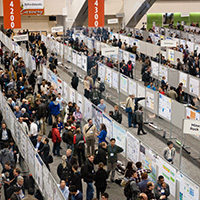
Mark Dwortzan | MIT Joint Program on the Science and Policy of Global Change
In December, several Joint Program researchers and affiliates shared recent findings at the American Geophysical Union’s (AGU) 2015 Fall Meeting in San Francisco, the largest Earth and space science conference in the world. They presented their research to nearly 24,000 attendees, who gathered to learn about the latest discoveries, trends and challenges in the field.
Research Scientist Andrei Sokolov presented a poster, “Climate Stabilization at 2oC and ‘Net Zero’ Emissions,” exploring potential greenhouse gas emissions reduction scenarios aimed at ensuring that the global average surface temperature does not exceed 2 degrees Celsius above pre-industrial levels, a key target in the recent COP21 climate negotiations in Paris.
In their study, Sokolov and his coauthors put to the test a claim that’s appeared in a number of recent publications—that to achieve the 2oC goal, net anthropogenic carbon dioxide (CO2) emissions must be reduced to zero between 2050 and 2100. Running several emissions-driven climate simulations from 1861 to 2500 using the MIT Integrated Global System Modeling framework, they produced findings suggesting that anthropogenic emissions need not zero out by 2050 or 2100 because of carbon sinks in oceans and terrestrial ecosystems. Assuming a median value of climate sensitivity, they showed that the desired result could be achieved by reducing annual CO2 emissions to about 50 percent of today’s levels by 2050, and 20 percent by 2100. Collaborators on Sokolov’s poster included three Joint Program researchers (Co-Director Ronald Prinn, Deputy Director and Senior Research Scientist Sergey Paltsev, and Research Scientist Y.-H. Henry Chen), and Shell International researcher Martin Haigh.
Noelle Selin, Esther and Harold E. Edgerton Career Development Associate Professor, Institute for Data, Systems and Society and Department of Earth, Atmospheric and Planetary Sciences, delivered a talk, “An Assessment of Uncertainty in Projections of Climate-Induced Changes to U.S. O3 Pollution,” on the use of models of 21st-century climate change and air quality to explore major sources of uncertainty in projections of climate-induced change to surface ozone (O3) over the U.S. Coupling the Community Atmosphere Model with Chemistry (CAM-Chem) to the MIT Integrated Global System Modeling (IGSM) framework, Selin and her coauthors evaluated and compared how the three main drivers of uncertainty in climate simulations—emissions scenario, model response and natural variability—propagate to estimates of O3 concentrations.
Their simulations of atmospheric chemistry in 2050 and 2100 suggest that climate change may increase U.S. O3 pollution substantially (to > 5 parts per billion) under a business-as-usual case. Greenhouse gas mitigation policies can significantly lessen these impacts. To quantify this effect given the variability in climate responses, however, this work showed that large ensemble simulations are required (>15 years of simulations).
Coauthored by postdoctoral associate Fernando Garcia Menendez and Research Scientist Erwan Monier, the study showed that projected impacts of climate change on O3 are largely dependent on uncertainties associated with natural variability and climate model response.
Monier was also a coauthor on two presentations by Joint Program affiliates: a talk delivered by Chris Forest [Pennsylvania State University) (“Towards Quantifying Robust Uncertainty Information for Climate Change Decision-making”) and a poster presented by David Kicklighter {Marine Biological Laboratory) (“Importance of Nitrogen Availability on Land Carbon Sequestration in Northern Eurasia during the 21st Century”).
Joint Program Deputy Director Adam Schlosser displayed a poster “Quantifying Climate Impacts of Urban Surface Albedo Using the WRF Model” on research for MIT’s Concrete Sustainability Hub project, focused on the impact of albedo—the proportion of incident light or radiation reflected by a surface—from buildings and paved surfaces in urban areas on surface-air temperature. An important part of the energy budget in shaping local and regional climate, surface albedo could also be a potential tool to mitigate the anthropogenic effect on climate. The study showed that the impact of elevating surface albedo has a cooling effect that’s robust at both local and regional scales.
“We ran the WRF model in a series of numerical experiments that modify the urban albedo over major metropolitan areas,” said Schlosser. “The effect is mainly local due to the coarse resolution of the model (50 km), but experiments planned in the coming year will increase the spatial resolution (10 km) to see if we find downstream effects.”
Joint Program Co-Director Ronald Prinn was also a coauthor on eight other posters or presentations related to the Advanced Global Atmospheric Gases Experiment (AGAGE), which has been measuring the composition of the global atmosphere continuously since 1978. Of those, four of the lead authors are current Joint Program postdoctoral fellows and graduate students (Langley DeWitt, Xuekun Fang, Jimmy Gasore and Michael McClellan), and two of the lead authors were formerly affiliated with the Joint Program and now based at the University of Bristol (Anita Ganesan, Matthew Rigby).
Photo: Poster Hall (Source: AGU)

